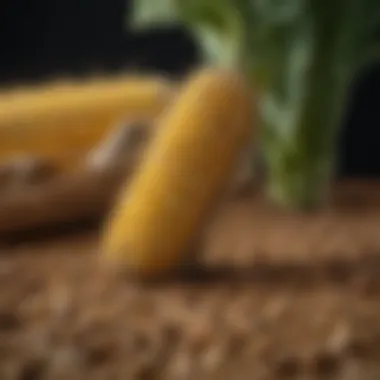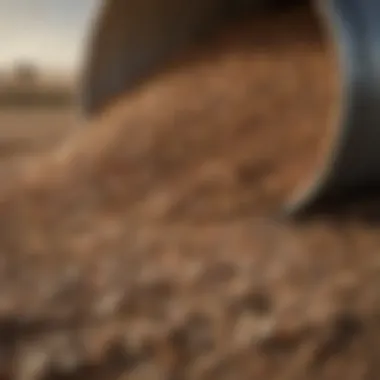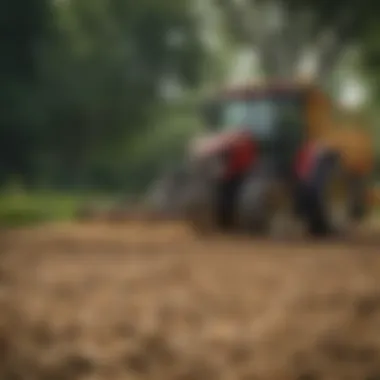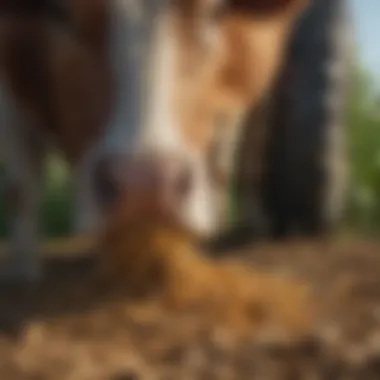Corn Silage Ration for Beef Cows: Key Insights


Intro
Corn silage is a vital component in the diet of beef cows, providing essential nutrients while also promoting efficiency in livestock management. As the beef industry continues to evolve, understanding the nuances of corn silage rations becomes crucial for farmers aiming for optimal herd health and productivity. Formulating an effective ration involves a careful balance of nutritional needs, management practices, and economic considerations. This article will delve into these aspects, providing a resourceful guide for both seasoned ranchers and those newer to beef farming.
By dissecting the complexities surrounding corn silage rations, we aim to illuminate not only what makes up a sound diet for beef cattle but also how various external factors shape feeding strategies in today's ever-changing agricultural landscape.
Key Concepts and Terminology
Understanding the foundation of corn silage rations requires familiarity with some key concepts and terms in livestock nutrition. This is important for anyone looking to formulate or understand beef cow diets effectively.
Basic Definitions
- Corn Silage: Fermented, high-moisture corn forage that serves as a primary feed source during the winter months when pastures are dormant.
- Ration: The total amount of feed given to an animal over a specified period, usually expressed on a dry matter basis.
- Nutritional Requirements: The essential vitamins, minerals, proteins, and carbohydrates that cattle need for growth, reproduction, and overall health.
Historical Context
The use of corn silage in beef diets isn't a new concept. Versioning back to the mid-20th century, it became popular due to its high energy content and palatability. Initially, corn silage was viewed as a supplemental option available during the feeding of hay or grains. Over time, research has revealed its benefits in improving weight gain and milk production by providing a more balanced nutrient intake.
Today, many farmers rely heavily on corn silage, particularly in regions where corn is grown abundantly. This reliance has spawned a plethora of research aimed at enhancing its nutritional value and feed efficiency.
Recent Innovations and Trends
As the agricultural sector takes leaps forward with technology and research, corn silage management evolves too. Here are some of the notable advancements:
Technological Advancements
Recent innovations have focused on refining the fermentation process to enhance nutrient preservation in corn silage. New inoculants that promote optimal fermentation can increase dry matter intake and overall digestibility.
Additionally, precision agriculture technologies allow ranchers to monitor silage quality more effectively. Using data analytics, farmers can optimize moisture levels and harvesting times, leading to improved feed quality.
Sustainable Practices
Sustainability plays a massive role in modern agriculture. Practices such as rotating silage crops and minimizing chemical usage not only preserve the environment but also enhance the soil's fertility. Cover crops are often utilized alongside corn silage to prevent soil erosion while providing additional forage.
Practical Applications and Techniques
Implementing the insights gained from research and best practices can significantly impact the efficiency of cattle farming. Here are a few practical approaches:
Step-by-step Guides
- Assess Nutritional Needs: Determine the specific energy, protein, and mineral requirements of your herd based on their stage of growth and production.
- Select the Right Silage: Choose the appropriate variety of corn that is compatible with your environmental conditions and nutritional goals.
- Monitor Fermentation: Regularly check the pH and moisture content of the silage to ensure optimal fermentation.
- Evaluate Rations: Utilize tools like nutrition calculators to balance your rations and ensure they meet the required parameters.
- Conduct Regular Assessments: Monitor cattle health, weight gain, and overall performance to identify adjustments needed in feeding strategies.
Case Studies
In practice, numerous farmers who adapted their rations to include higher quality corn silage have reported increases in weight gain and feed efficiency. For instance, a producer in Iowa transitioned from traditional hay to a corn silage-based diet and noted a 20% increase in daily weight gain during the winter months.
"Incorporating corn silage was a game changer for my operation. Not only did it improve my cattle’s health, but it also saved me on feed costs, which is always a bonus." - Local Iowa Beef Producer
Understanding and employing the strategies that surround corn silage rations is essential for those involved in beef production. With the right information, farmers can navigate the complexities of cattle nutrition while also staying attuned to emerging research and trends that can directly affect their operations.
Prologue to Corn Silage as Livestock Feed
Corn silage serves as a cornerstone in livestock feeding, especially for beef cows. This feed type is derived from the entire corn plant, and it packs a substantial punch when it comes to nutrition. The significance of corn silage lies not just in its availability, but also in its cost-effectiveness and high digestibility compared to other forage options. In the challenging landscape of agricultural practices, understanding the intricacies of corn silage becomes vital for farmers aiming to optimize their cattle's health and productivity.
When beef cows receive corn silage in their diet, they benefit from a balanced intake of carbohydrates, proteins, and essential nutrients. As one can imagine, having quality feed means beef cows will likely demonstrate improved growth rates, better reproduction, and overall enhanced performance.
Moreover, incorporating corn silage can lead to a more economical ration. With growing concerns about feed costs, turning towards corn silage presents a practical solution. It’s long lasting, and when stored properly, the feed maintains its nutritional profile over time. This article aims to provide an extensive understanding of corn silage as livestock feed, focusing particularly on its definitions, significance, production methods, and the nuances that go into formulating effective rations.
Definitions and Importance
Corn silage can be defined simply as a fermented feed product created by preserving chopped corn plants in anaerobic conditions. This fermentation process not only helps in preservation but also enhances the nutritional value of the feed. The importance of corn silage transcends mere definitions; it serves as a high-energy feed that is rich in fiber, making it a viable choice in beef cattle diets.
Corn silage's contributions extend beyond nutrition alone. For farmers, including silage in rations means they can manage their resources better. Its ability to deliver energy efficiently means that cattle can convert feed into weight gain more effectively, which aligns neatly with the profitability targets of any cattle operation. This isn’t merely a theoretical notion; many producers have witnessed tangible benefits firsthand.
Overview of Corn Silage Production
Producing corn silage involves multiple phases, right from selecting the right hybrids of corn, ensuring optimal planting times, to harvesting techniques that minimize loss. It begins in the fields, where the corn is cultivated. Factors like soil quality and moisture play crucial roles here, as they directly affect the yield and nutrient density of the silage. Once harvested, the entire plant is chopped into small pieces and packed tightly into silos or bunkers, ensuring exclusion of air.
After a fermentation period— usually a few weeks— the corn is ready to use. The silage retains its nutrients during this time, provided that the storage conditions are correctly managed. Additionally, the process is quite efficient; a single acre of corn can produce a significant amount of silage, making it an attractive option for many beef operations. Understanding these production aspects is crucial for farmers looking to leverage corn silage in their feeding programs.


Nutritional Composition of Corn Silage
Understanding the nutritional composition of corn silage is fundamental for those in the beef cattle industry. This segment of the article sheds light on how the right blend of nutrients in corn silage can make a significant impact on the health, productivity, and overall efficiency of beef cows. Corn silage serves as a valuable forage, rich not only in energy but also in essential macronutrients and micronutrients necessary for cattle to thrive.
Macro and Micronutrient Profiles
When it comes to the macro and micronutrient profiles of corn silage, it’s worth noting that these elements dictate the overall effectiveness of the feed. Corn silage is generally high in carbohydrates, which provide a primary source of energy. This is vital for beef cows, especially during the lactation and growth phases.
Other significant components include:
- Protein: Though slightly lower than some other forage options, it provides adequate nourishment when combined with supplements.
- Fiber: The NDF (Neutral Detergent Fiber) levels affect digestibility and are crucial for rumen health.
- Fat: While present in smaller amounts, it can enhance caloric density in rations and improve energy intake.
Micronutrients, although needed in smaller quantities, still play a critical role. Minerals like calcium, phosphorus, and trace elements such as zinc and copper influence bone health and immune function.
"Understanding nutrient profiles helps farmers optimize rations, leading to healthier herds and improved growth rates."
Impact of Maturity on Nutrient Quality
The impact of maturity on nutrient quality cannot be understated. As corn matures, there is an observable shift in its nutritional profile. Younger, immature corn plants generally have higher protein and sugar content while also being more digestible. As the corn continues to mature, particularly past the dent stage, the starch levels increase, but protein content and digestibility often decrease.
This timeline necessitates careful planning in feed management. Some considerations include:
- Timing the harvest to maximize nutrient quality
- Balancing rations according to the growth stage of the corn
- Understanding that too late of a harvest can lead to lower animal performance
Variability Among Different Hybrids
Variability in different corn hybrids is an intriguing aspect that can influence silage quality significantly. Hybrid selection is essential for tailoring feed to meet the specific needs of the cattle. Some hybrids are bred specifically for higher starch content, leading to better energy profiles but may compromise on fiber or protein content.
Key points to consider include:
- Researching hybrid characteristics to find those suited for specific feeding scenarios.
- Understanding the geographical and climatic influences on hybrid performance.
- Regularly testing silage to ensure the feeding program aligns with cattle nutritional needs.
This understanding of hybrid variability is not just academic. It translates directly into practical applications, affecting not only cow performance but also farm profitability over time.
Formulating the Ration: Key Considerations
Formulating the correct ration for beef cows is a keystone in advancing livestock health and production efficiency. As cattlemen and women strive for optimal performance in their herds, grasping the specific considerations of feed formulation lays the groundwork for this goal. A thoughtfully constructed ration not only bolsters growth and reproduction rates but also enhances overall animal welfare. The strategic blending of ingredients like corn silage with other feedstuffs contributes significantly to achieving this balance, ensuring that's neither too rich nor too lean.
Energy Requirements of Beef Cows
When it comes to energy needs, it is essential to tailor the diet to the specific life stages of the cows. Energy fuels vital processes, from daily maintenance to growth spurts in young animals or lactation in mothers. A rough estimate is that mature beef cows require around 12 to 14 megacalories of net energy per day, with variations depending on factors such as size, breed, and reproductive status. Neglecting to meet these energy requirements can lead to poor performance, lower milk production, and weight loss.
Often overlooked, the digestibility of the corn silage itself plays a pivotal role. The dry matter content can impact how much energy the cows effectively extract from their feed. Hence, prioritizing high-quality silage that is well-preserved helps meet these energy needs while reducing the likelihood of digestive issues such as acidosis.
Protein Needs and Sources
Protein is the building block of animal growth, and beef cows are no exception. A cow requires a sufficient amount of protein to maintain muscle mass, support lactation, and foster growth in young ones. Generally, the protein content in a corn silage ration is inadequate to meet the demands of high-performing beef cows, which typically call for 10-14% crude protein.
Many producers opt for supplements to boost protein in their ration, incorporating sources such as soybean meal, alfalfa, or commercial protein supplements. Careful selection of these ingredients based on their protein content and digestibility is crucial. The balance here is delicate; too much protein can lead to excess nitrogen excretion, harming the environment. Providing not just any protein, but quality protein, ensures that cows get the benefit without the waste.
Balancing Forages and Concentrates
The final consideration in formulating a balanced ration lies in the interaction between forages and concentrates. Forages, such as corn silage, provide essential fiber that supports proper gut function, while concentrates, which are energy-dense, can be manipulated to meet energy requirements swiftly. It's a classic push and pull; too much concentrate can result in digestive upset, while insufficient amounts may not meet energy needs, causing cows to experience weight loss or a decrease in milk production.
Finding that harmony is key. Ideally, a balanced ration could consist of roughly 60-70% forages and 30-40% concentrates. Monitoring how cows respond to this balance—through growth rates, body condition scores, and litter sizes—can lead to fine-tuning the diet and ultimately improving herd performance.
In summary, the considerations around formulating rations for beef cows are intricate but essential. Adequately addressing energy needs, ensuring sufficient protein intake, and finding the right balance between forages and concentrates serves as the bedrock for optimizing health and productivity in herds. By mastering these elements, producers can confidently enhance their feeding strategies.
Supplemental Feeds in Corn Silage Rations
When considering the complete nutritional picture for beef cows, supplemental feeds play a significant role alongside corn silage. These additions complement the base forage, ensuring that cattle meet their dietary needs for optimal health and performance. Supplemental feeds can enhance the nutrient status, improve overall digestibility, and help to balance the ration, making them an essential component in formulating feeding strategies.
By integrating various supplemental feeds, farmers can target specific deficiencies or enhance certain qualities of their livestock's diet. Factors influencing the choice of these feeds include their availability, cost, and intended purpose within the ration. The rationale is straightforward: without adequate supplements, cattle may suffer from deficiencies that hinder weight gain or reproductive success.
Role of Grain and Other Feeds
Grain is often a staple in supplemental feeding for beef cows. It serves as a concentrated energy source, vital for building muscle and promoting growth. Corn, barley, and oats are among the preferred types. Grain typically has higher digestible energy compared to forages, which means it can lead to faster fat deposition or weight gain when fed properly.
- Energy Density: Grains provide a higher caloric intake in a smaller volume, critical during times when cows need to pack on weight or during lactation.
- Appetite Stimulation: The palatability of grains usually encourages cows to eat more, further utilizing the nutrients effectively.
- Cost-Effectiveness: Depending on local prices, feeding grains can be a relatively budget-friendly option to enhance dietary energy.


While grains are beneficial, they must be introduced cautiously to avoid digestive disorders. Too much grain too quickly can lead to acidosis, which poses serious health risks. Balkan-style feeding methods, which gradually increase the amount of grain, can help mitigate this concern.
Mineral and Vitamin Supplementation
Vitamins and minerals constitute an undeniable part of a balanced diet for beef cows. The deficiency in essential nutrients can negatively affect growth rates, immune function, and overall productivity. Some crucial minerals and vitamins to consider include:
- Calcium and Phosphorus: These are vital for bone health and support reproductive efficiency. A typical deficiency can lead to issues like milk fever or impaired muscle function.
- Trace Minerals: Elements such as zinc, selenium, and copper play roles in metabolic processes and can boost resilience against disease.
- Vitamins A, D, and E: These vitamins are essential for normal growth and reproduction. A deficiency, for instance, can compromise the reproductive performance of heifer and cow alike.
Supplementation can be dispensed in various forms: loose minerals, mineral blocks, or pre-mixed feed. Each option carries benefits, depending on how animals are fed and the setup of the farm. Moreover, the quality of forages, such as corn silage, can significantly impact the amount of vitamins and minerals needed.
Regularly monitoring cow health and assessing nutrient status through blood tests or feeding trials helps adjust the ration accordingly. As research progresses, enhanced methods for fortifying rations become available, providing further opportunities for optimizing health and productivity in beef cows.
Management Practices for Optimal Feeding
Incorporating sound management practices when feeding corn silage to beef cows is crucial. It ensures that the livestock receive maximum nutritional benefits and promotes overall health and productivity. The complexities of feeding cattle require attention to detail and a commitment to optimizing feeding strategies.
Storage and Preservation of Corn Silage
Proper storage and preservation techniques for corn silage can significantly affect its quality and nutritional value. Corn silage needs to be preserved in an anaerobic environment to prevent spoilage and nutrient loss. One major practice is to pack the silage tightly in silos or bunkers. By minimizing air pockets during storage, you help sustain a strong fermentation process that enhances nutrient retention.
When it comes to moisture content, keeping it between 60% to 70% is ideal. Too wet, and you risk seepage losses, while too dry can lead to spoilage due to insufficient fermentation. Monitoring the fermentation process can also help, as indicators such as pH levels inform you of the silage's state. When properly managed, corn silage can remain fresh for several months, making it a reliable feed source for cattle.
Effective storage helps prevent wastage and maximizes feed efficiency.
Monitoring and Adjusting Rations
Monitoring and adjusting corn silage rations is an ongoing process. It's not merely a one-time decision; it’s a dynamic adjustment anchored in continuous evaluation of the cows’ performance and the silage’s quality. For example, regular weight checks of beef cattle can provide insights into how well they are responding to their feed rations. If a cow isn’t gaining weight or is losing condition, it may be time to tweak the ration composition or add supplements.
Also, other factors come into play—changes in season, individual health of cows, and even variations in silage quality. These differences can necessitate frequent adjustments to ensure nutritional needs are consistently met.
Setting a standard feeding schedule can help optimize intake levels, but having the flexibility to make changes when needed is just as vital. A hands-on approach to monitoring can lead to better health outcomes for your herd and enhance productivity, ensuring your feeding practices are both efficient and effective.
Economic Implications of Corn Silage Rationing
Optimizing corn silage rationing goes beyond nutritional values and livestock health; it also carries significant economic implications. In the world of beef farming, where margins can be razor thin, the costs associated with feeding livestock directly influence overall profitability. Therefore, understanding the economic landscape of corn silage rationing is essential for farmers looking to maintain or elevate their operational standards.
The economic considerations include both the upfront costs of harvesting and storing corn silage as well as the subsequent impact on the productivity of the cattle. When carefully managed, corn silage can lead to substantial feed cost reductions compared to traditional grain-based rations. This impacts farmers’ bottom line significantly.
Farmers must assess the cost-effectiveness of the ration ingredients while also evaluating the potential returns of enhanced animal performance. This necessitates a thorough evaluation of livestock feeding regimes, tailored to capitalize on the advantages of corn silage.
Cost-Effectiveness Analysis
Conducting a cost-effectiveness analysis involves a systematic approach to analyze both direct and indirect costs associated with corn silage utilization. This analysis will typically focus on:
- Harvesting Costs: Includes labor, machinery, and materials for corn cutting and ensiling.
- Storage Expenses: Refers to the costs for maintaining silage in optimal conditions to prevent spoilage.
- Ration Formulation Costs: Costs linked to supplementing rations with necessary minerals and other feed types.
- Inflationary Pressures: Keeping an eye on feed prices and how market trends can affect overall supply costs.
By weighing these components against the expected growth rates and reproductive performance of the beef cows, farmers can derive insights into whether the savings and benefits justify the investment. For instance, the optimization of a corn silage ration can lead to improved feed conversion ratios, which directly influences profitability.
"A penny saved is a penny earned," and in modern beef production, understanding the nuances of feed input costs can be the difference between profit and loss.
Return on Investment in Feed Inputs
Return on Investment (ROI) in feed inputs is another critical element in the economic discussion surrounding corn silage. This involves analyzing how investment in silage and supplementary feeds translates into higher productivity and improved profitability. Important factors to consider are:
- Yield Improvement: If a properly formulated corn silage ration contributes to better weight gain among cattle, the value derived from that greater weight may surpass the initial feed costs.
- Longevity of Cows: Enhanced nutrition can lead to healthier animals that stay productive longer, translating into lower replacement costs over time.
- Market Demand: A quality product resulting from effective rationing may fetch better market prices, thus increasing the return.
When calculating ROI, it’s prudent for farmers to assess both short-term and long-term economic impacts. The holistic view, combining immediate feeding costs with the sustained benefits that arise from a carefully crafted corn silage ration, allows for meticulous planning and strategic decision-making in the farming operations. In essence, successful corn silage feeding can catalyze a transformative shift in beef profitability, merging nutrition with economic feasibility.
Impact on Beef Cow Health and Performance
The health and productivity of beef cows are deeply intertwined with their diet. Understanding how corn silage affects these factors is critical for ranchers aiming for high-efficiency production while maintaining the wellbeing of the animals. Corn silage, with its high-energy content and palatability, can significantly support the growth and reproductive efficiency of beef cows when incorporated thoughtfully into their rations.
Influence on Growth Rates and Reproduction
When we speak about growth rates in beef cattle, it’s not simply about seeing larger animals at the end of the feeding cycle; it's about developing robust, healthy cows that can reproduce efficiently. Corn silage offers a generous dose of carbohydrates that promotes energy intake, pivotal for both weight gain and milk production in lactating cows. Notably, well-fed heifers tend to reach maturity earlier and can breed successfully at a younger age, which translates into more calving cycles throughout their lifespan.
Moreover, the fiber in corn silage aids in digestive health, supporting a well-functioning rumen. Healthy rumen function allows for better nutrient absorption, which is essential for optimal growth. Lack of proper nutrition can stall growth rates or, worse, lead to reproductive issues such as delayed estrus.
"A well-balanced ration involving corn silage can make the difference between a thriving herd and one that struggles to meet production goals."


To optimize growth, it’s key for farmers to regularly monitor both the quantity and quality of silage fed. Any shortcoming in these areas—like stale silage or improper fermentation—can lead to the cows missing out on vital nutrients needed for substantial weight gain.
Nutritional Challenges and Solutions
As with any feeding program, there are hurdles to navigate when integrating corn silage into the diet. One challenge is the inconsistency in the nutritional profile of corn silage, which can vary with factors like hybrid selection, growing conditions, and harvesting timing. For instance, corn harvested too early might lack adequate energy levels, throwing off the whole ration balance.
To combat these issues, producers should perform regular nutrient analysis on their corn silage. Knowing the specific nutrient content can aid in creating a more precise ration that meets an individual herd’s needs. If deficit nutrients are identified, they can either adjust the silage composition or incorporate supplementary feeds. For example, adding soybean meal or cottonseed to the diet can counterbalance low protein levels in some silage varieties.
Additionally, maintaining good storage practices is crucial. Poorly stored silage can lead to spoilage and mycotoxins, which pose health risks for cattle. Implementing best practices like proper sealing of silage piles and ensuring anaerobic fermentation can help mitigate these risks. Furthermore, educating oneself about fermentation processes and the importance of moisture levels can lead to more stable silage that holds its nutritional value better.
Through vigilant management, ranchers can navigate the complexities of feeding corn silage, addressing challenges while leveraging its benefits to maintain the overall health and productivity of beef cows.
Recent Research and Trends in Corn Silage Feeding
In the ever-evolving landscape of livestock nutrition, recent research and trends in corn silage feeding hold significant implications for beef cow management and productivity. With advancements in agricultural science, understanding these facets contributes not only to the health of the cattle but also to economic viability for farmers. By adapting feeding strategies based on the latest findings, producers can optimize the potential of corn silage as a primary feed source.
Innovations in Corn Breeding and Silage Mixes
The breeding of corn for silage has seen innovations aimed at enhancing the feed's nutritional profile and digestibility. Varieties with higher starch content can lead to better energy conversion in beef cows, which is crucial for optimal weight gain and milk production. Research indicates that specific hybrids might outperform traditional options when it comes to silage quality. For instance, hybrids bred for higher sugar content have shown promise, as sugars can improve fermentation processes and overall digestibility.
- Key benefits of these innovations:
- Improved digestibility leads to enhanced nutrient absorption.
- Higher energy yield directly correlates to beef cow growth and performance.
- Reduction in waste during the fermentation process.
A handful of farmers are already experimenting with these high-performance hybrids, tailoring mixtures that reflect their specific operational needs. This bespoke approach allows for maximizing resource efficiency and output productivity, keeping profit margins in check.
Sustainability and Environmental Considerations
As awareness regarding environmental impact grows, sustainability is becoming an integral part of the discussion around corn silage feeding practices. Encouraging responsible growth methods not only targets greater efficiency in forage production but also aims to reduce the carbon footprint of beef cattle farming.
Incorporating crop rotation and cover cropping plays a pivotal role. Not only does it enhance soil health, but it also aids in maintaining moisture levels and reducing runoff. Research shows that by improving soil quality, corn silage yields can increase sustainably, providing cleaner production cycles without sacrif icing animal health.
- Sustainable practices to consider:
- Implementing integrated pest management strategies to limit chemical usage.
- Focusing on water conservation techniques during cultivation.
- Using biodegradable materials for silage bags and storage.
"Sustainability isn’t just a catchphrase; it’s a necessity for the future of farming. Incorporating these practices ensures that we can produce food not just today but for generations to come."
Case Studies and Practical Examples
Case studies offer a window into real-world applications and scenarios that can be immensely beneficial for comprehending the complexities of formulating corn silage rations. These examples provide practical insights that not only exemplify successful implementations but also highlight potential pitfalls that producers can avoid. The significance lies in their ability to turn theoretical knowledge into actionable strategies. By analyzing specific cases, we can identify what works, what doesn’t, and how factors such as environment, cow health, and supply chain issues can influence ration formulation.
Successful Ration Formulations
When discussing successful ration formulations, one can't overlook the importance of adapting to the specific needs of the herd and the resources available. For instance, a cattle ranch in Nebraska adopted a strategy that involved mixing corn silage with a byproduct feed like distillers grains. This combination provided a balanced ratio of energy and protein, leading to improved weight gain among their beef cattle by a significant margin, approximately 20% over six months, compared to previous feeding methods.
Several key factors contributed to their success:
- Customizing the Formulation: The ranch tailored its ration based on the daily needs of the cattle, taking into account their weight, age, and reproductive stage.
- Ingredient Testing: Regularly testing the nutritional content of corn silage helped them adjust the ration dynamically, ensuring consistency in quality.
- Monitoring Performance: By keeping diligent records of growth rates, veterinarians were able to correlate the feed adjustments directly to improvements in cow health and productivity.
This case exemplifies how a practical application of knowledge leads to measurable results in cattle performance.
Lessons from Producers
The experiences of other producers serve as invaluable learning resources when it comes to corn silage rations. In a study focusing on producers in Wisconsin, several themes emerged that could benefit others:
- Community Knowledge Sharing: Many farmers engaged in local groups not only to exchange best practices but also to discuss challenges they faced with their rations. This collaboration led to innovative solutions, such as sourcing local feeds that were more nutritious and cost-effective.
- Adapting to Market Fluctuations: A common lesson involved being vigilant about changes in grain prices. One farmer learned the hard way that over-reliance on purchased feeds could lead to increased costs, prompting him to grow his own supplementary feeds to stabilize his expenses.
- Observation and Flexibility: It was noted that not every cow will respond the same way to the same feed. One producer emphasized the need to observe individual animal behavior and health closely, adjusting rations as necessary based on visual cues and veterinary guidance.
"The best teacher is experience. Each herd is unique; what works for one may not fit another. Pay attention, adapt, and you’ll find your path to success." — A Wisconsin Beef Producer
In sum, these case studies and lessons emphasize that learning from practical examples is crucial in achieving and maintaining optimal corn silage rations. By staying connected with fellow producers and adapting strategies based on real-world experiences, livestock growers can enhance the health and productivity of their cattle, ensuring a thriving enterprise.
Culmination and Future Directions
In wrapping things up, it’s essential to reflect on the multifaceted nature of corn silage as a formidable feeding strategy for beef cows. The subject of corn silage rationing stands out, chiefly due to its pivotal role in enhancing both the productivity and health of beef cattle. It cultivates a sensitive balance between nutritional composition, economic viability, and practical application, influencing various sectors within the livestock industry. The importance of keeping abreast of innovations cannot be overstated; the landscape of cattle feeding is continuously evolving with the advent of new research and environmental considerations. This section sheds light on where we stand today and the roadmap ahead regarding corn silage feeding strategies.
Summarizing Key Takeaways
- Nutritional Wealth of Corn Silage: It’s undeniably a significant source of energy and crucial nutrients needed for beef cattle. The rich macro and micronutrient profiles are fundamental in formulating effective rations.
- Flexibility in Formulation: As demonstrated throughout the article, customizing rations to meet specific needs—whether for growth or reproduction—offers a distinct advantage in achieving optimal cattle performance. Balancing forage with concentrates can lead to improved feed efficiency.
- Economic Considerations: The cost-effectiveness of corn silage rations is pivotal for farmers looking at long-term sustainability. Thorough analysis of return on investment helps steer financial decisions in raising beef cattle.
- Management is Crucial: Best practices in storage, monitoring, and adjusting rations can drastically affect the quality of silage consumed and thus impact overall cattle health.
- Continuous Research and Adaptation: Keeping a finger on the pulse of recent research trends can unveil new strategies and hybrids, further enriching our feeding approaches.
Looking Ahead: Innovations and Challenges
The future of corn silage for beef cows isn’t merely a path of opportunities; it also presents various challenges that require keen attention. Innovations in corn breeding could lead to varieties engineered specifically for silage production, enhancing nutritional value and resilience against pests and diseases. Additionally, as sustainability becomes increasingly important, attention towards environmentally-friendly practices in silage production cannot be ignored.
However, as promising as these innovations seem, they bring along their own set of challenges. Higher initial costs for new hybrids, potential market fluctuations, and the need for farmer education regarding advanced feeding strategies could pose obstacles in the immediate future.
Overall, embracing a forward-thinking mindset is vital. Farmers and agricultural experts must remain vigilant in addressing these challenges while leveraging new findings to refine and enhance the feeding strategies they employ. By doing so, they can ensure the sustainable success of beef cattle operations for years to come.















